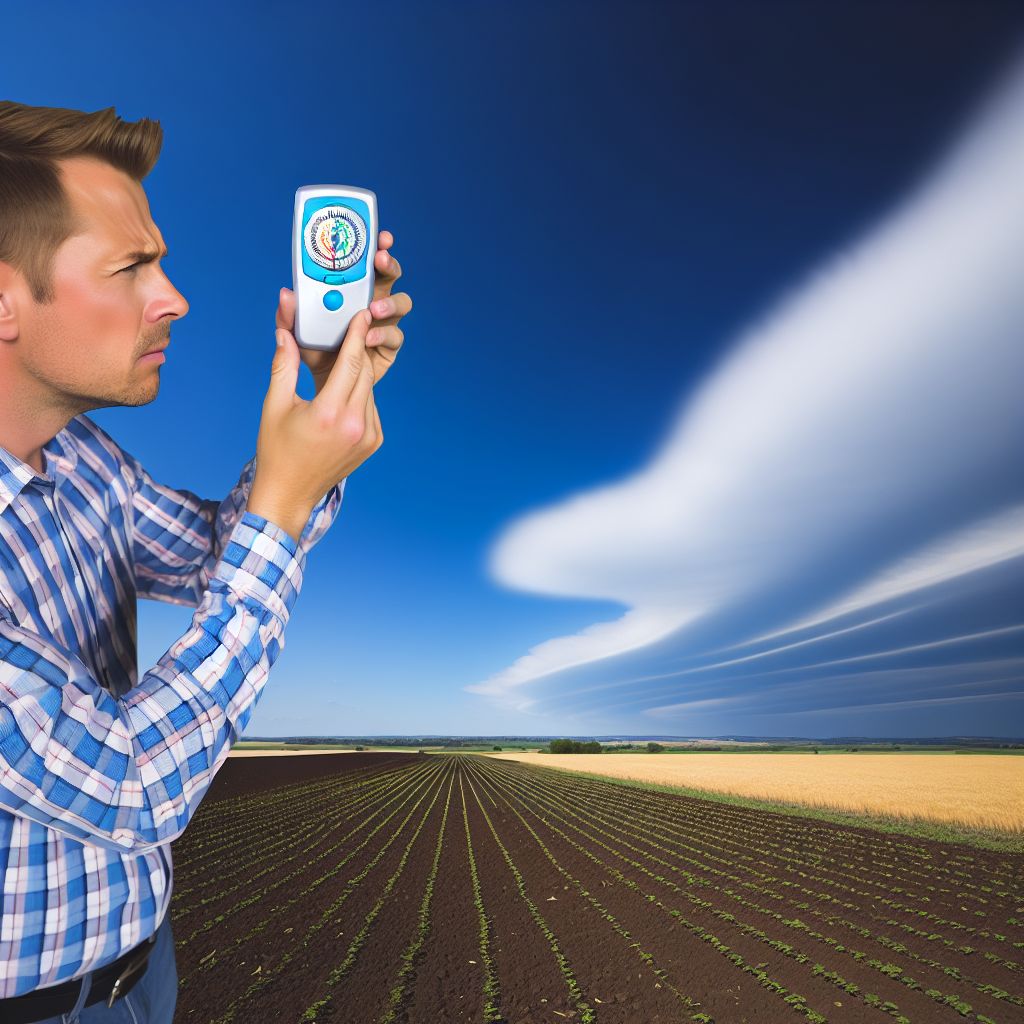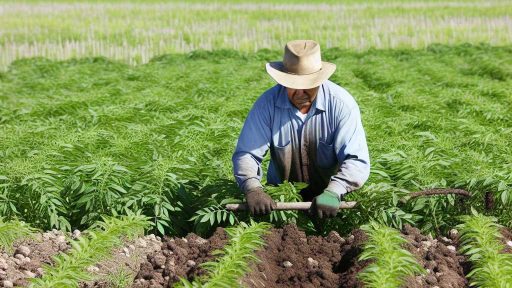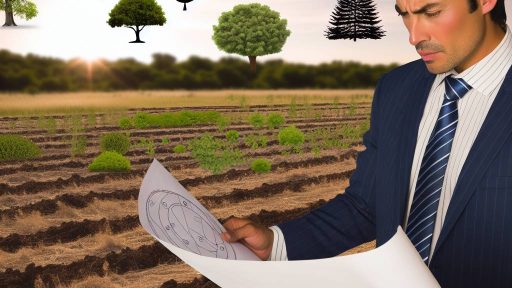Understanding Temperature Trends and Their Effect on Farmland
Importance of Temperature Trends
Temperature trends play a critical role in agriculture today.
They influence the growth and yield of various crops.
Farmers must understand these trends for effective planning.
Impact on Crop Growth
Temperature significantly affects the phenology of crops.
It determines planting and harvesting times.
Extreme temperatures can stress plants and reduce yields.
Soil Health and Microbial Activity
Soil temperature affects microbial activity within the soil.
Healthy microbes are essential for nutrient absorption.
Consequently, changes in temperature can alter soil composition.
Water Availability and Irrigation Needs
Temperature directly impacts evaporation rates from soil and water bodies.
Higher temperatures can lead to increased irrigation needs.
Farmers must consider these factors for water resource management.
Long-term Agricultural Planning
Understanding temperature trends enables better long-term agricultural strategies.
Farmers can select crop varieties resilient to changing conditions.
This proactive approach supports sustainable farming practices.
Transform Your Agribusiness
Unlock your farm's potential with expert advice tailored to your needs. Get actionable steps that drive real results.
Get StartedMoreover, it prepares farmers for future climate uncertainties.
Overview of Global Climate Change and Its Impact on Temperature Patterns
Global climate change increasingly affects our planet’s temperature patterns.
Rising greenhouse gas emissions contribute significantly to this change.
As a result, global temperatures are climbing at alarming rates.
This warming influences various aspects of our ecosystems.
Moreover, it disrupts natural weather patterns worldwide.
Temperature Increases and Their Effects
Scientists have documented noticeable increases in average global temperatures.
Recent reports indicate a rise of approximately 1.2°C since pre-industrial times.
This increase translates into severe weather events and changes in rainfall patterns.
Farmers are often on the front lines of these changes.
Their crops require specific temperature ranges for optimal growth.
Impact on Agriculture and Farmland
Temperature fluctuations influence crop yields directly.
Some regions experience increased pests and diseases due to warmer temperatures.
This impact stresses farmers and can decrease food availability.
Additionally, droughts and floods become more frequent and intense.
Such extreme conditions challenge traditional farming practices.
Adaptation Strategies for Farmers
Farmers must adapt to the changing climate to remain viable.
Implementing water-saving technologies is one effective strategy.
Crop diversification can enhance resilience against temperature shifts.
Moreover, investing in climate-resilient crop varieties matters significantly.
These strategies enable farmers to cope with ongoing temperature trends.
Historical Temperature Data Analysis and Observed Trends Over Time
Introduction to Historical Temperature Data
Historical temperature data provides a foundation for understanding climate patterns.
This data spans many years and reveals crucial trends.
Scientists use various sources to gather this information, including weather stations and satellite observations.
Showcase Your Farming Business
Publish your professional farming services profile on our blog for a one-time fee of $200 and reach a dedicated audience of farmers and agribusiness owners.
Publish Your ProfileAnalysis of Temperature Trends
Temperature trends can be analyzed using statistical methods.
These methods help identify significant changes over specific periods.
For example, researchers often calculate average temperatures to observe trends.
Additionally, they assess extremes, such as record highs and lows.
Rising Average Temperatures
Data indicates a consistent rise in global average temperatures.
This increase has accelerated in recent decades.
In fact, the last decade was the hottest on record globally.
Regional Variations in Temperature Trends
Temperature trends can significantly vary by region.
For instance, some areas experience more considerable warming than others.
Regions like the Arctic have seen dramatic increases compared to global averages.
Impact of Temperature Trends on Agriculture
Changing temperatures directly affect farmland productivity.
Farmers must adapt their practices in response to these shifts.
For instance, warmer temperatures can lead to early planting times.
However, they may also increase the risk of crops failing.
Effects on Crop Yields
Temperature changes influence crop development cycles.
For example, higher temperatures can accelerate growth but may reduce yield quality.
Additionally, heat stress can affect crop health adversely.
Shifts in Pest and Disease Patterns
As temperatures rise, pest populations may also change.
Warmer climates can allow pests to thrive in new regions.
This shift may lead to increased agricultural losses for farmers.
Addressing Temperature Data for Future Planning
Understanding historical temperature trends is crucial for effective agricultural planning.
Farmers, scientists, and policymakers must work together to mitigate the impacts of these trends.
Ultimately, adapting to climate changes will ensure the sustainability of global agriculture.
Gain More Insights: Soil Erosion Control Methods for Sustainable Real Estate Development
Regional Variations in Temperature Trends
Understanding Temperature Changes
Temperature trends vary significantly across different regions.
These variations result from geographic, climatic, and human factors.
For instance, coastal areas often experience milder temperatures.
Conversely, inland regions may face broader temperature swings.
Both of these variations impact agricultural practices directly.
Implications for Different Types of Farmland
Diverse farming practices exist, influenced by specific temperature trends.
For example, warmer regions benefit from longer growing seasons.
This leads to the cultivation of a wider array of crops.
On the other hand, colder areas may struggle with shorter seasons.
Consequently, farmers must adapt their crop choices and planting schedules.
Crop Diversity and Farmer Adaptation
Crop diversity enhances resilience to temperature fluctuations.
Farmers can plant heat-tolerant varieties in warmer regions.
In cooler climates, they might select cold-resistant plants.
This diversification helps mitigate the risks associated with temperature changes.
Regional Case Studies
The Midwest U.S. showcases varied temperature impacts on agriculture.
Here, temperature increases have led to altered planting schedules.
Showcase Your Farming Business
Publish your professional farming services profile on our blog for a one-time fee of $200 and reach a dedicated audience of farmers and agribusiness owners.
Publish Your ProfileAdditionally, the Southeastern U.S. experiences increased rainfall variability.
These trends require farmers to consider irrigation solutions.
By understanding their specific regions, farmers can make informed decisions.
Future Implications on Agricultural Practices
Future temperature trends indicate potential challenges for farmland.
Adaptation strategies will become crucial for long-term viability.
Farmers may need to explore innovative techniques for crop production.
Research and technology will play a vital role in this transition.
Cultivating adaptive practices can safeguard agricultural sustainability.
Delve into the Subject: Best Irrigation Practices for Reducing Water Waste in Farming
Effects of Temperature Extremes on Crop Yield and Health
Impact of Heatwaves
Heatwaves significantly challenge crop yield and health.
Extreme heat stresses plants and hampers growth.
Crops such as wheat and corn exhibit reduced yields during high temperatures.
Additionally, excessive heat can cause wilting and leaf scorch.
Farmers must monitor temperature trends closely.
They can implement irrigation strategies to mitigate impacts.
For instance, mulching conserves soil moisture and reduces heat stress.
Impact of Cold Snaps
Cold snaps pose a different threat to crops.
Sudden drops in temperature can damage young plants.
Frost can kill blossoms, leading to significant yield losses.
Vegetables like tomatoes and peppers are particularly vulnerable.
Farmers may utilize row covers to protect crops during cold spells.
They can also select hardier varieties for colder climates.
Long-Term Implications
As temperature extremes become more common, farmers face ongoing challenges.
Altered growing seasons affect crop planning and management.
Sustainable farming practices can help adapt to these changes.
For example, crop rotation enhances soil resilience under temperature stress.
Farmers should invest in research and technology for better predictions.
Precision agriculture tools can optimize resource use during extreme weather.
Ultimately, understanding temperature trends is crucial for future food security.
You Might Also Like: How AgTech Innovations Shape Rural Real Estate and Land Development
Adaptation Strategies for Farmers in Response to Changing Temperature Patterns
Understanding the Need for Adaptation
Farmers face significant challenges due to fluctuating temperatures.
These shifts can affect crop yields and livestock productivity.
Thus, understanding local climate changes is essential for successful farming.
Farmers must adapt their practices to remain viable in this changing climate.
Implementing Crop Diversification
Crop diversification is a critical adaptation strategy.
It reduces the risk associated with climate variability.
Farmers can choose heat-resistant crop varieties to withstand higher temperatures.
Additionally, they can introduce new crops suited for the changing climate.
This strategy enhances the resilience of agricultural systems.
Utilizing Water Management Techniques
Water management is crucial in adapting to temperature increases.
Showcase Your Farming Business
Publish your professional farming services profile on our blog for a one-time fee of $200 and reach a dedicated audience of farmers and agribusiness owners.
Publish Your ProfileFarmers should consider irrigation systems to optimize water usage.
Implementing drip irrigation can significantly reduce water waste.
Moreover, rainwater harvesting can provide valuable resources during dry spells.
Adopting Sustainable Farming Practices
Sustainable farming practices can help mitigate climate effects.
Practices such as no-till farming improve soil health and moisture retention.
Additionally, integrating cover crops enhances biodiversity and nutrient cycling.
Farmers should also engage in crop rotation to prevent soil depletion.
Monitoring and Utilizing Technology
Technology plays a vital role in modern farming adaptations.
Farmers can use climate-monitoring tools to make informed decisions.
Precision agriculture techniques enable efficient resource use.
Furthermore, drones can assist in monitoring crop health and soil conditions.
Collaborating with Local Agricultural Organizations
Collaboration with local agricultural organizations can foster adaptation.
These organizations often provide resources and information for farmers.
Participating in workshops and training can enhance farming techniques.
Moreover, networking with fellow farmers offers valuable insights and shared experiences.
Discover More: How Climate Affects Pest Control Strategies in Farmland Communities

The Role of Technology in Monitoring Temperature Trends and Managing Farmland
Importance of Temperature Monitoring
Monitoring temperature trends is crucial for effective farmland management.
Temperature affects crop growth, yield, and soil health.
Farmers need accurate information to make informed decisions.
Technology provides tools to gather and analyze this data.
Technological Innovations in Temperature Measurement
Various devices aid in temperature measurement on farms.
Weather stations collect real-time temperature data.
Sensors placed in fields monitor soil and air temperatures.
Remote sensing technology allows for broader data collection.
Data Analysis for Effective Management
Analyzing temperature data helps identify trends over time.
Farmers can adjust planting schedules based on this information.
Data analysis also supports optimized irrigation practices.
Furthermore, it aids in pest and disease management strategies.
Integration with IoT and Precision Agriculture
The Internet of Things (IoT) enhances temperature monitoring.
Smart devices connect farmers to real-time data remotely.
This connectivity improves decision-making processes.
Precision agriculture techniques further optimize resource use.
Case Studies and Real-World Applications
Many farms successfully implement technology for temperature monitoring.
For example, GreenField Farms uses sensor data to adjust irrigation.
Another example includes Sunny Acres, which tracks temperature trends for crop planning.
These case studies illustrate technology’s benefits in agriculture.
Future Projections for Temperature Changes and Potential Impacts on Agriculture
Projected Temperature Increases
Climate models predict significant temperature increases over the next few decades.
By 2050, average global temperatures may rise by 1.5 to 2 degrees Celsius.
This increase will likely affect farming practices worldwide.
Impact on Crop Yields
Higher temperatures can lead to decreased crop yields.
Showcase Your Farming Business
Publish your professional farming services profile on our blog for a one-time fee of $200 and reach a dedicated audience of farmers and agribusiness owners.
Publish Your ProfileCrops such as wheat and corn are particularly vulnerable.
Moreover, heat stress can inhibit plant growth and development.
Changes in Precipitation Patterns
Temperature changes will also alter precipitation patterns.
Some regions may experience increased rainfall, while others may face drought.
Consequently, inconsistent water availability will challenge farmers.
Effects on Soil Health
Rising temperatures can negatively impact soil health.
Soil erosion rates may increase due to extreme weather events.
This erosion depletes nutrients essential for crop growth.
Impacts on Pest and Disease Dynamics
Warmer temperatures create favorable conditions for pests and diseases.
As a result, farmers might face increased pest invasions.
These changes necessitate adjustments in pest management strategies.
Adaptation Strategies
Farmers will need to adopt new practices to cope with temperature changes.
Crop rotation can help maintain soil health and fertility.
Additionally, implementing irrigation systems may mitigate drought effects.
Technology and Innovation
Advancements in technology will play a crucial role in adaptation.
Precision agriculture can optimize resource use and improve yields.
Furthermore, genetically modified crops can enhance resilience to heat and pests.
Case Studies of Successful Farming Practices in Response to Temperature Challenges
Innovative Irrigation Techniques
Farmers are adopting advanced irrigation technologies to combat rising temperatures.
For instance, Sarah Whitfield used drip irrigation on her tomato farm.
This method significantly reduced water usage while improving crop yields.
Moreover, smart irrigation systems allow real-time monitoring of soil moisture.
Consequently, they optimize water delivery based on specific plant needs.
Drought-Resistant Crop Varieties
Many farmers now choose drought-resistant crop varieties to enhance resilience.
John Martinez shifted to planting sorghum and millet on his land.
These crops require less water and thrive in hotter climates.
As a result, he improved his harvest even during dry spells.
This shift not only saved resources but also boosted his profits.
Soil Management Practices
Effective soil management plays a critical role in adapting to temperature changes.
Linda Chen implemented cover cropping techniques on her farm.
This practice increases organic matter and improves soil health.
Furthermore, it helps retain moisture during hotter months.
By enhancing soil quality, she has seen a significant increase in crop resilience.
Community Support and Education
Networked communities are also amplifying successful farming strategies.
The local farmers’ cooperative launched workshops to share knowledge.
They teach techniques like crop rotation and sustainable pest management.
As a result, farmers are more equipped to handle climate-related challenges.
This sense of community fosters resilience across the agricultural sector.
Additional Resources
Impacts of climate change on the fate of contaminants through …
Climate Change Impacts on Agriculture and Food Supply | US EPA




